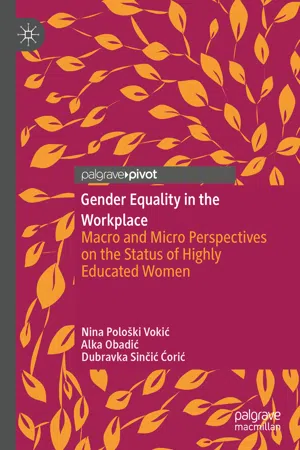The gender revolution is present all around the world. Gender egalitarianism 1 is gaining momentum over gender stereotyping and gender segregation2 (e.g. McDaniel, 2016; Mussida & Picchio, 2014; Walby, 2011), leading to greater gender equality3 than ever before. Women have improved their position both in society and in labour markets worldwide. They have caught up with men in rates of higher-education graduation and increased their participation in formerly male-dominated fields of study. They have effectively increased their representation in the workforce, their involvement in paid employment in terms of working hours, their representation in formerly male-dominated industries and occupations, and as a consequence, the gender pay gap has declined (e.g. Costa, Caçador, Carvalho, Breda, & Costa, 2014; England, 2010; Schweitzer, Ng, Lyons, & Kuron, 2011; Stier & Herzberg-Drucker, 2017).
Although many countries around the globe have placed gender equality at the top of their agendas and have prioritised gender equality in their public policies (OECD, 2017), gender segregation remains, even in relatively gender-equal countries. Regardless of societal, cultural, legislative and organisational efforts to promote gender equality and equal opportunities in society and the workplace, women in both developed and developing countries continue to experience gender inequality in terms of their roles, education, labour market participation, occupations, hierarchical positions, career advancement, compensation, political representation and so on (e.g. Burke & Singh, 2014; Cuberes & Teignier, 2016; Morais Maceira, 2017; Mussida & Picchio, 2014; Perrons, 2017; Tellhed, Bäckström, & Björklund, 2017). According to the Organisation for Economic Co-operation and Development (OECD), in spite of women’s gains in society and the labour market, women are much less likely to study in lucrative fields; are still less likely than men to engage in paid work or to work full time; tend to be in lower-paid sectors and occupations; are less likely to reach management and executive levels; earn less than men on average and remain underrepresented in politics (OECD, 2017).
The gender queue hypothesis , the hypothesis that women continue to lag behind men (Stier & Herzberg-Drucker, 2017), is even more disturbing when considering the spillover effect of gender inequality —the effect when gender inequality in one domain, such as education, spills over into other domains, such as employment (e.g. Morais Maceira, 2017). As a result, addressing the different aspects of gender inequality together as a whole is likely to have more positive impacts than addressing each aspect of gender inequality separately (Morais Maceira, 2017). Consequently, we can talk about a ‘vicious circle or loop’—not only that general areas of gender segregation (essentialist segregation, educational segregation, employment segregation, occupational segregation, hierarchical segregation and pay segregation) interact and interweave with each other, but induce gender segregation in specific areas (such as politics, entrepreneurship and science, technology, engineering and mathematics [STEM]).
Gender inequality remains a defining characteristic of social and economic life across countries in 2010s (e.g. Eurofond, 2018; OECD, 2017). Women, as coined by Dunn (1999 as cited in Bell, 2012), can still be called ‘the 51% minority’. Moreover, despite advances made by women in various areas, the level of segregation has barely changed since the early 1990s (Sparreboom, 2014). According to England (2011), the gender revolution has stalled insofar as the progress on a number of fronts has either slowed or stopped. The stalled trend hypothesis precisely suggests a curvilinear trend in gender segregation—first a decline and then a stalled or reversed trend (van de Werfhorst, 2017). For example, Tomaskovic-Devey and associates (2006 as cited in England, 2011) exhibited that the rate of desegregation by gender has slowed. They found that segregation declined at an average pace of 1.8% per year between 1966 and 1980, but at a slower pace of 1.5% per year betwe...
